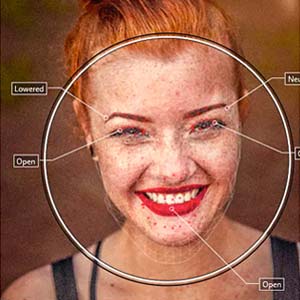Why you should use custom expressions in your facial expression analysis

Using custom expressions in facial expression analysis can unlock a deeper understanding of human behavior. How can you use custom expressions in different fields of research?
Posted by
Published on
Tue 06 Feb. 2024
Topics
| Behavioral Research | FaceReader | Facial Expression Analysis | Measure Emotions |
When delving into the complexities of human emotion, researchers often turn to the Facial Action Coding System (FACS), which breaks down facial expressions into individual components known as Action Units (AUs). Using these AUs - in combination with other metrics - it is possible to create your own custom facial expressions for your research. How can you use these custom expressions in different fields of research? And how do you create them in your facial expression software, like FaceReader?
Benefits of custom expressions
The use of custom expressions in facial expression analysis is a growing field. They offer benefits for researchers across various disciplines. That's because custom expressions can unlock a deeper understanding of human behavior that basic facial expressions might not reveal. Curious about how it could benefit your research? Below, we list some of the ways that custom facial expression enrich different fields of study.
Clinical psychology: beyond the basic emotions
In clinical settings, the precision that custom expressions offer can be invaluable. For example, a standard set of expressions may not capture the nuanced difference between sadness and melancholy, or between a genuine and a social smile. By measuring custom expressions, researchers can discern these subtleties, helping to provide more accurate diagnosis and treatment planning.
Developmental psychology: formation of emotional expression
Developmental psychologists can benefit greatly from custom expressions by observing the formation and variation of expressions in young children. This can help in understanding developmental milestones and the emergence of social and emotional skills. In developmental psychology, custom expressions of interest may include subtle expressions of empathy, confusion, concentration, or frustration.
User experience: fine-tuning feedback
In the field of user experience (UX) research, custom expressions allow for a more detailed analysis of user satisfaction. Instead of simply identifying frustration, custom expressions can differentiate between confusion, overwhelm, or disappointment. This provides actionable insights for product or website development, helping companies to better meet user needs.
Also read this blog post if you want to know more about how to study human behavior.
Neuroscience: better insights into cognitive processes
Neuroscientists can use custom expressions to correlate specific facial movements with brain activity. For example, researchers may want to study expressions of concentration, frustration, or anxiety, helping them to find biomarkers for neurological conditions and shed light on memory processes. They may also gain insights into affective states associated with cognitive tasks.
Human factors: enhancing safety and performance
Custom expressions can play a critical role in optimizing safety and efficiency within human-machine interactions. By analyzing the specific combinations of AUs that signal cognitive load, boredom, anxiety, or stress, researchers can design more intuitive interfaces and controls. For example, we can learn when pilots get overloaded in complex decision-making by measuring their specific reactions in a flight simulator, prompting the redesign of cockpit alerts to prevent real-world incidents.
Neuromarketing: understanding consumer emotion
Researchers in neuromarketing may use custom expressions to delve into the subconscious reactions of consumers. By identifying the subtlest shifts in facial expressions that may indicate confusion, skepticism, or delight, brands can measure genuine emotional responses to products, advertisements, and shopping experiences. This type of feedback goes beyond what traditional surveys can capture, allowing marketers to fine-tune campaigns for their target audience.
Creating and using custom expressions in FaceReader
When you're working with FaceReader, custom expressions are available in the Action Unit module. The software allows you to add different input blocks to form a custom expression, like action units, basic emotions, heart rate, and head orientation. Next, you choose how you want to combine and process these input blocks. With this formula, FaceReader calculates your custom expression in real-time.
Because you create your calculation beforehand, you can see the response right away and treat your custom expression like any other facial expression in the software. This will also save you a lot of processing time.
The power of custom expressions in research
The key to successful facial expression analysis is not just in recognizing an emotion, but in understanding its complexity and context. Custom expressions enable researchers to study behaviors or emotions that basic expressions can’t always capture. This helps them to gain insights into emotions with a level of detail that was previously unattainable. This deeper analysis can lead to more personalized and effective interventions, products, and therapies.
Did you know? With FaceReader Online, you can measure facial expressions from any location. Read more in our blog post Why you should use FaceReader Online for your human behavior research.
Related Posts

Facial expressions - reactions to bitter food vary between high and low BMI

The role of facial expression of emotion in joint activities


